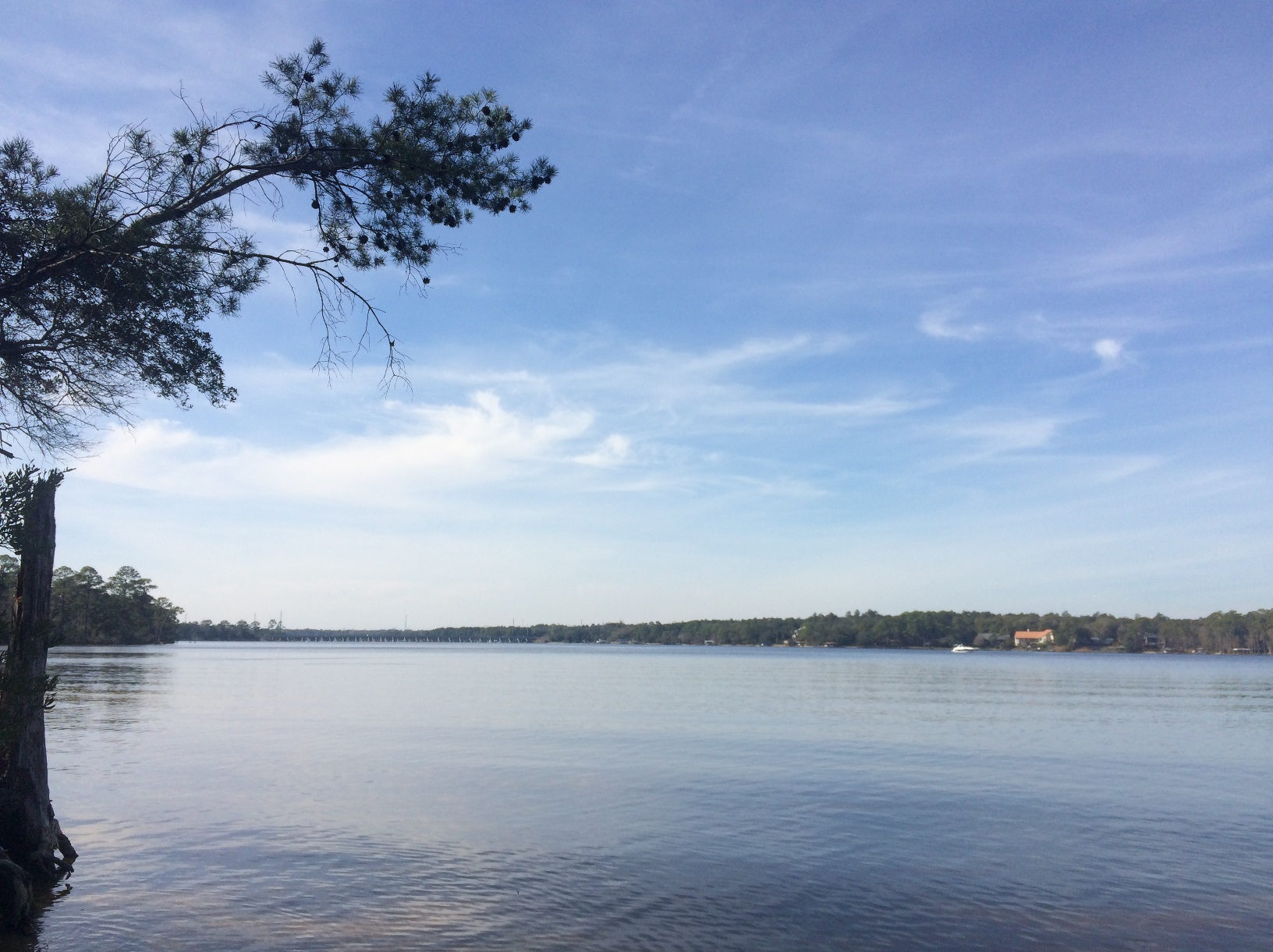
by Laura Tiu | Sep 23, 2016
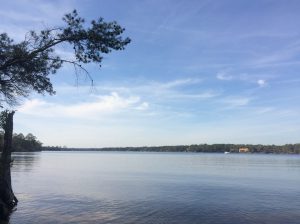
Rocky Bayou Aquatic Preserve – Choctawhatchee Bay, Niceville, Florida – Photo by Laura Tiu
September 17-24, 2016 was the nation’s 28th time to celebrate America’s coasts and estuaries during National Estuaries Week. This week helps us to remember to appreciate the challenges these coastal ecosystems face, along with their beauty and utility.
Estuaries, semi-enclosed bodies of water with both fresh and saltwater, dot the Gulf Coast of the United States from Brownsville Texas to Key West, Florida. These estuaries are important as they serve as drainage basins for many of the large river systems, and play a significant role in the nation’s seafood industry.
Florida’s six major Panhandle estuaries, which includes Perdido Bay, Pensacola Bay (including Escambia Bay), Choctawhatchee Bay, St. Andrew Bay, St. Joseph Bay and Apalachicola Bay, are unique ecosystems teeming with life and diversity. Critical habitat includes important seagrass beds that support both the larval and adult stages of fish and invertebrates. In Choctawhatchee Bay, there is also critical foraging habitat for the federally protected Gulf sturgeon (Acipenser oxyrinchus desotoi) and stream habitat for the endangered Okaloosa darter.
Choctawhatchee Bay is in Okaloosa and Walton counties in the Florida Panhandle. It is approximately 30 miles long and from three and a half to six miles wide, with a total area of 129 square miles. It is relatively shallow varying from 10 to 40 feet deep. Large portions of the western half of Choctawhatchee Bay are militarily restricted (Eglin Airforce Base). The Bay is fed by the Choctawhatchee River and numerous small creeks that feed into several bayous. The only opening to the Gulf of Mexico is the East Pass, which ironically is at the Western end of the Bay in Destin, Florida. This is where the saltwater and freshwater mix.
Continued industrial and residential development in the watershed regions that drain into many of these estuaries has impacted them in a number of ways. Pollution comes from storm water runoff, lawns, industry and farms. The shorelines are impacted by development, which causes sedimentation and in turn loss of vegetation. This reduces water clarity and habitat for wildlife.
Many organizations work to protect this estuary and reach out to others through education, restoration, and recreation events. Choctawhatchee Basin Alliance (CBA) is one such organization committed to ensuring sustainable utilization of the Choctawhatchee River and Bay. They, working with their partners, provide leadership for the stewardship of the Bay. Alison McDowell, director of the CBA, notes that 75-85% of commercially and recreationally important species that are caught in the Gulf spend part of their lifecycle in the Bay. McDowell says a key factor in the Bay’s health is monitoring the water quality and reducing erosion, and the Oyster Reef Restoration program started in 2006 does just that.
There are often opportunities for the general public to join in some of the conservation efforts taking place in the Bay. For more information, like the Okaloosa or Walton County Extension Facebook page.
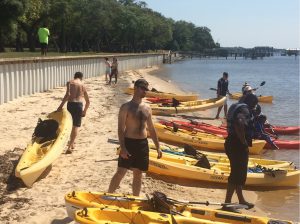
Kayaking Choctawhatchee Bay – Photo by Laura Tiu
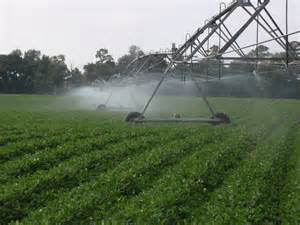
by Rick O'Connor | Jul 31, 2016
On a recent camping trip out west I was made aware of just how valuable water is. The American west has been battling water issues for a few years now. Some camp showers had buttons that would provide you water for a couple of minutes, others charged $.50 for four minutes, some charged $1.00 for four minutes. Not one campsite had water available at the site. You had to walk, load your container, and return. This forced you to be a little wiser on how you used it. You did not want to have to go back and get more very often.
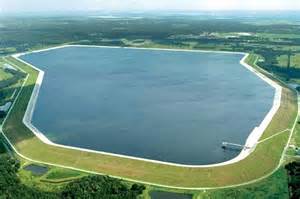
The Bill Young Reservoir in south Florida.
Photo: Southwest Florida Water Management District
However, I was troubled by some of the things I saw as I traveled through the southwest. Areas in the desert where farmers were trying to grow row crops, citrus, and pecans – irrigation systems set up everywhere, reservoirs with canals and dikes to feed much needed water to the farmers… and signs in town where you could buy water to drink at $.25/gallon. It seemed an inefficient use of this resource. It would make more sense to grow crops that used less water, maybe… no water. Recently we have heard a lot about “water wars” and “water rights” in the American southwest. Farmers seeking more, municipalities trying to grab their piece of the pie, football fields and golf courses, and even camp grounds. Some locations you cannot wash your car, or your dogs. It is a real dilemma they are facing. There were numerous creeks and streams I drove over that were absolutely dry, cattle in open rangeland seeking anywhere to find something to drink.
Could this happen in Northwest Florida?
You would think not. In the book Mirage by Cynthia Barnett, it mentions a comment made by Major John Wesley Powell. Major Powell was an ex-confederate officer who was hired by the U.S. Geological Survey to survey land across the south and to the southwest after the Civil War. He mentions problems with developing the American southwest primarily due to the lack of water… but water was something that Florida would never have to worry about – the state was saturated. And yet here we are… 150 years later discussing water rights in Florida. Currently it does not appear to be an issue. At any campground in Florida you will find a water source at each site and you can take a shower as long as you like – at no charge. We are one of the most productive agricultural states in the country – producing row crops, citrus, and cattle. Most in our communities have manicured watered lawns and many have swimming pools. There does not seem to be a problem here. BUT, many communities are beginning to see problems. Salt water intrusion into the water supply, lowering of the water table and aquifers, and even some streams running low. Could we… Florida… the land of water… be heading towards a “water war”?

This is a common method used to irrigate crops across the U.S.
Photo: UF IFAS
The University of Florida Extension Program has recently hired water management specialists in districts across the state. They will be looking at issues that include water quantity and quality to address the needs of each region. These specialists, along with the county faculty, will be working with local residents to discuss the local issues and help mitigate problems that could be looming on the horizon. We encourage all residents to consider how to better manage their water. Think in terms as if you had a set amount each month – budget this to meet your needs – and stick to your budget. Hopefully with research, education, and insight, we can avoid a true “Water War”.





